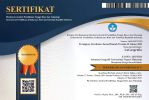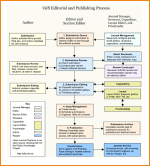Kontribusi Usaha Gogos Terhadap Pendapatan Rumah Tangga
(1) Universitas Negeri Makassar
(2) Universitas Negeri Makassar
(3) Universitas Negeri Makassar
(*) Corresponding Author
DOI: https://doi.org/10.35580/lageografia.v19i2.19666
Abstract
This study aims to determine: 1) How is the socio-economic condition of gogos traders in Jalange, Mallawa Village, Mallusetasi District, Barru Regency, 2) How big is the contribution of gogos business to household income in Jalange, Mallawa Village, Mallusetasi District, Barru Regency. The population in this study were all households engaged in gogos business in Jalange, Mallawa Village, totaling 37 families. The sample in this study amounted to 37 people because the population is less than 100. This research is a descriptive study. The results showed 1) the socio-economic condition of the people who worked selling gogos, namely the age of 39-43 years as much as 29.71%, graduated from high school as much as 45.95%. The livelihoods of respondents apart from gogos were various, including entrepreneurs, private workers, construction workers, farmers and fishermen. The majority of the household income of gogos sellers in Jalange, Mallawa Village is Rp. 1,000,000. The highest income from the sale of gogos is Rp. 2,500,000 per month and the lowest is Rp. 500,000 per month. 2) The contribution of gogos business to household income which makes gogos the main job reaches 100% for 5 units of gogos sellers and the highest contribution is for households that make gogos as an alternative to increasing household income reaching 59%. This shows that gogos has a fairly large role in increasing household income
Keywords
Full Text:
PDFReferences
Aldillah, R. (2016). Kinerja pemanfaatan mekanisasi pertanian dan implikasinya dalam upaya percepatan produksi pangan di Indonesia. Forum Penelitian Agro Ekonomi, 34(2), 163–171.
Hasang, I. (2019). KONTRIBUSI SEKTOR PERTANIAN TERHADAP PERTUMBUHAN EKONOMI DAN PENYERAPAN TENAGA KERJA DI KABUPATEN BARRU. Economos: Jurnal Ekonomi Dan Bisnis, 2(3), 151–157.
Irdayanti, D. F. (2019). KONTRIBUSI PENDAPATAN INDUSTRI KUNYIT BUBUK TERHADAP PENDAPATAN KELUARGA DI DESA GUNUNG SILANU KECAMATAN BANGKALAKABUPATEN JENEPONTO. Jurnal Environmental Science, 1(2).
Joesyiana, K. (2017). Strategi Pengembangan Industri Rumah Tangga Di Kota Pekanbaru. VALUTA, 3(1), 159–172.
Kusumaningrum, S. I. (2019). Pemanfaatan Sektor Pertanian sebagai Penunjang Pertumbuhan Perekonomian Indonesia. TRANSAKSI, 11(1), 80–89.
Nyompa, S., Dewi, N. A. S., & Sideng, U. (2020). Dampak Keberadaan Tambang Pasir Terhadap Kondisi Sosial Ekonomi Masyarakat di Desa Cimpu Utara Kecamatan Suli Kabupaten Luwu. LaGeografia, 18(2), 137–149.
Rukajat, A. (2018). Pendekatan penelitian kuantitatif: quantitative research approach. Deepublish.
Rukka, R. M., Busthanul, N., & Fatonny, N. (2018). STRATEGI PENGEMBANGAN BISNIS KERIPIK BAYAM. Jurnal Sosial Ekonomi Pertanian, 14(1), 41–54.
Syahruddin, S. (2019). Kontribusi Hasil Tambak Udang Windu Terhadap Tingkat Kesejahteraan Rumah Tangga Petani Tambak di Kelurahan Lakkang Kecamatan Tallo Kota Makassar. LaGeografia. https://doi.org/10.35580/lga.v17i3.9539
Article Metrics
Abstract view : 307 times | PDF view : 121 timesRefbacks
- There are currently no refbacks.
Copyright (c) 2021 Ade Esti Aadila, Uca Sideng, Hasriyanti Hasriyanti

This work is licensed under a Creative Commons Attribution-NonCommercial 4.0 International License.
LaGeografia: Jurnal Program Studi Pendidikan Geografi, Jurusan Geografi, Fakultas MIPA, Universitas Negeri Makassar.
Email: lageografia@unm.ac.id | +6285298749260
Editorial Office













































